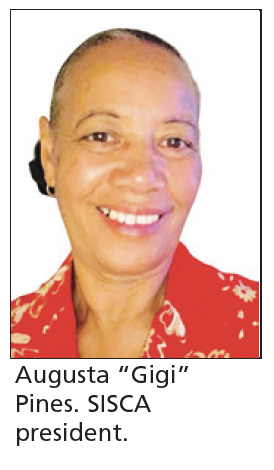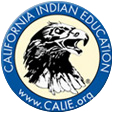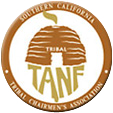
America’s Backbone Awakens
Dedicated to Preserving Our Legacy:
A Brief History of SISCA and an Interview with Its President
by Windy Goodloe, SISCA secretary
“Why didn’t I learn this in school?” is a phrase that we hear often when a person first learns about the Seminole Negro Indian Scouts. The story of these brave men often leaves people scratching their heads. They find it hard to believe that a story filled with so much action and adventure and conflict and triumph hasn’t been made into one hundred movies, let alone one. As descendants, we’ve wondered why our history wasn’t (and still isn’t) taught in our local schools. It hasn’t been for lack of trying. One of our most prominent members was a school teacher who dedicated her life to telling the story of her people to anyone who would listen, and if it wasn’t for her, I probably wouldn’t be writing this article right now.
The Seminole Indian Scouts Cemetery Association (SISCA) was founded in 1967 by Miss Charles Emily Wilson, who was a beloved educator. SISCA’s mission is to preserve, promote, and maintain the Seminole Indian Scouts Cemetery, which is located in Brackettville, Texas. The cemetery was founded in 1872, just two years after the formation of the Seminole Negro Indian Scouts.
Once Seminole Negro Indian Scouts were mustered into service, they went on to serve as a detachment of the US Army from 1870 to 1914. During their forty-four years of service, these men served bravely and never lost a man in battle. As a matter of fact, four of the scouts were Congressional Medal of Honor recipients. Their names were Pompey Factor, Adam Payne, Isaac Payne, and John Ward. All four of these men were buried in the Seminole Indian Scouts Cemetery, making it a historic landmark.
While the graves of the four Congressional Medal of Honor recipients draw many tourists, the cemetery is a very sacred place for the descendants of the Seminole Negro Indian Scouts. Many of our loved ones are buried there. It is their final resting place, and it is the place that many of us plan to be buried one day.
Because we know that our ancestors were always seeking safety and freedom,we know that their lives weren’t always easy. Therefore, their struggles are never far from our minds. This is just one reason why telling the story of the Black Seminoles and keeping their legacy alive is so important to us. For instance, the year 2020 was a big milestone for history of the Seminole Negro Indian Scouts. It marked 150 years since the first men were mustered into service at Fort Duncan in Eagle Pass, Texas. Although our plans for a large celebration had to be cancelled because of the coronavirus, we took the festivities online and have enjoyed the opportunity to extend our observance.
Along with the cemetery, SISCA also maintains the Carver School Grounds, where two historic buildings are located. These two buildings were used as a school for Black Seminole students during segregation. Once segregation ended, the students began attending Brackett ISD. For the past forty years, the Carver School Grounds have been the location of our two big celebrations – Juneteenth (June 19/Emancipation Day) and Seminole Days (celebrated the third weekend in September).
In 2015, the Seminole Negro Indian Scouts Museum was founded. The founding of our museum was a special event for us. It was actually founded on April 25, which was the same day that Pompey Factor, Isaac Payne, and John Ward received the Congressional Medal of Honor in 1875. Even though it is very small and humble, it is the space where we get to tell our story in a new and interesting way.
It is imperative that we acknowledge that we wouldn’t have achieved most of our goals without intelligent and compassionate leadership.
Augusta Pines has been president of SISCA since 2013. Under her leadership, SISCA has flourished, both online and offline. Ms. Pines’ motivation has always been to “make Miss Charles proud.” With this in mind, Augusta Pines continues to lead SISCA into the future while highlighting the past.
Q: What has your relationship with SISCA been like?
A: I have been a member of SISCA for a very long time. I became active because I enjoyed being around Miss Charles. I have so many memories of helping her the night before or the day of Juneteenth or Seminole Days. There were some years when we didn’t think anyone would show up, but we always prepared for a crowd. So my relationship with SISCA started because of my relationship with Miss Charles. I always wanted to be around her and help her because I respected her as my teacher and as a person who always seemed to want the best for everyone.
Q: How has your leadership helped SISCA?
A: I see myself as a motivator. I like to see people come together, so during Juneteenth and Seminole Days, I am always happy to see how all of our hard work paid off. I like seeing people discover more and more about their history. I enjoy being a part of an organization that helps people learn more about themselves.
Q:What do you hope for the future of SISCA?
A: I hope that SISCA keeps going forward in a positive way. I hope SISCA inspires Black Seminoles … and everybody, really … to become interested in their history. I think we can only get better and stronger. My goal is to continue teaching about our legacy and building on that legacy. We have a lot of work to do, but I think we have a lot of people who are willing to do the work with us, and that makes me happy because I know that we have a lot of support. I always think about Miss Charles, and I wonder if she would be happy with our progress. I’d like to think that she would be.
For more information about the Seminole Indian
Scouts Cemetery Association, please visit our website
www.seminolecemeteryassociation.com or email us
at This email address is being protected from spambots. You need JavaScript enabled to view it.. You can also
follow us on Facebook, Twitter, and Instagram.





